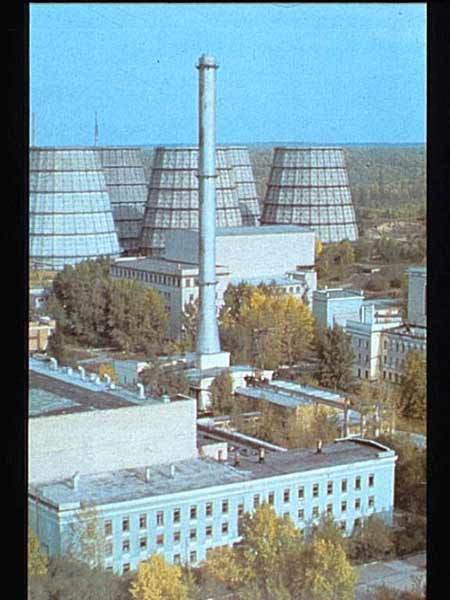A fissile element produced in nuclear reactors
In February 1941 the American physicist Glenn Seaborg discovered the ninety-fourth element of the classification of Mendeleev: plutonium. The best known isotope of this « transuranic » element is plutonium-239, which is the nucleus the most abundantly produced in nuclear reactors. Generated by neutron captures in uranium-238, plutonium-239 is fissile.
of this « transuranic » element is plutonium-239, which is the nucleus the most abundantly produced in nuclear reactors. Generated by neutron captures in uranium-238, plutonium-239 is fissile.

Ces réacteurs du site de Tomsk-7, en Sibérie, étaient destinés à produire du plutonium à des fins militaires. Il existe actuellement des programmes ambitieux, comme AIDA-MOX, destinés à recycler ce plutonium russe (et également du plutonium américain) de qualité militaire à des fins énergétiques civiles.
© CEA
Plutonium-239 is not an ordinary nucleus . It could be used as an explosive in atomic bombs or as a fuel in reactors. At the same time produced and burned in nuclear reactors, it offers a virtually inexhaustible energy source. More easily fissile than uranium-235, plutonium is wanted for making atomic weapons or to propel aircraft carriers and submarines. A joke of the Nobel Prize in Physics Georges Charpak sums up the dilemma : « For an accountant, a ton of plutonium is worth 25 million dollars, for an engineer it provides 1,000 megawatts of electricity over a year, for Saddam Hussein it amounts to 250 nuclear bombs ».
Fission of plutonium-239 provides more secondary neutrons than uranium-235: 2.91 on average, of which 2.30 may trigger a further fission when captured. The fission probability is the highest when slow neutrons are used. Fast neutrons are able to split all the plutonium isotopes and allow « breeding ».
Because of the role played by plutonium-239, one often forgets that the plutonium contains other isotopes isotopes among which plutonium-241 is also fissile. Within conventional pressurized water reactor burning enriched uranium fuel, plutonium 239 represents 58% of the plutonium found in the discharged spent fuel. Adding plutonium-241, fissile isotopes represent about 70% of this plutonium.
Weapon-grade plutonium should contain more than 90 % of pluonium-239. For that reason plutonium produced by civilian reactiors are unfit for atomic bombs.
When plutonium is not recycled in a reactor, it becomes a waste that will require a deep underground storage in repositories. The quantity of plutonium present today in the world is estimated to be around 1000 tons. According to some experts “fissionable uranium reserves (easily exploitable) would not exceed 72 years ». It may be therefore useful to have plutonium available in a remote future if oil reserves also begin to run out, since it offers the potential with breeder reactors of an almost inexhaustible energy source.
Other articles on the subject « Nuclear Fuel »
Nuclear Fuel Cycle
The front-end and the back-end of the cycle… The nuclear fuel cycle includes all nuclear op[...]
Cycle Front End
From the extraction of uranium to the fuel fabrication The front-end of the nuclear cycle is the [...]
Isotopic Separation
The access key to the fuel of modern nuclear power plants … and to atomic weapons The uranium fue[...]
Ultracentrifugation
A separation process economical in energy, but proliferating The principle of centrifuges has lon[...]
Gaseous Diffusion
The first enrichment process, a large consumer of electricity The gaseous diffusion process was t[...]
PWR fuel assemblies
Fuel assemblies in the core of PWR Reactors The core of a pressurized water reactor (PWR) is cont[...]
Reactor fuel layout
Fuel assemblies in the core of nuclear reactors The nuclear fuel assemblies, that vary from one r[...]
Pu : Fuel, bomb or Waste ?
Plutonium dark and bright sides … Sensitive material, like the roman god Janus, plutonium h[...]
MOX fuels
Introducing plutonium in nuclear fuels For energy production, plutonum is gold ! One gram of plut[...]
Thorium Fuels
Uranium 233: a fissile nucleus made from thorium Thorium is more abundant than uranium in the Ear[...]